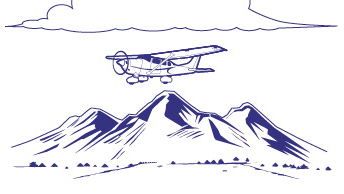Flight Lesson: Hope at the End of the Canyon
Mountain peaks lurk in the dark

A stressful flying season was almost over. I had departed Kotzebue, Alaska, several days earlier and cleared Canadian customs at Beaver Creek, Yukon Territory. I stayed overnight in Whitehorse and departed at 9 a.m. My goal for the day was Prince George, British Columbia, and if time permitted all the way home. Arriving in Dease Lake, British Columbia, about two and a half hours later, I topped off the tanks in my Cessna 206, ate, and departed for Prince George.
I arrived about 3 p.m. Sunset was predicted to be about 5:30 p.m. With 324 nautical miles remaining, it would be about a three-and-a-half-hour flight allowing for the winds. A stop at Williams Lake, British Columbia, for the U.S. Customs notification requirement would add a half-hour to the elapsed time.
The flight to Williams Lake was uneventful. The weather ahead was a bit worse, with an overcast with its base at about 5,000 to 6,000 feet msl.
My filed route for this final leg took me into the Fraser River canyon to follow the river to the vicinity of Abbotsford, British Columbia; then direct to Bellingham, Washington. The canyon is bounded by mountains with tops at 6,000 feet msl and higher. As I neared the north end of the canyon, it was about a half-hour before sunset. The overcast ahead was solid.
Into the canyon I went at about 2,500 feet msl and 120 knots. As I worked my way along, the light was diminishing more rapidly than I had expected. I slowed to 90 knots to allow me more reaction time, since the terrain was no longer easily distinguishable. The road, however, was identifiable from the presence of a small number of vehicles on it.
Turning back was now as bad an option as continuing. I considered climbing through the overcast, but would not be able to get a clearance as I was out of radio contact; and the terrain was too high and too close for a safe climb in instrument conditions.
I continued, cross-checking what I could see outside with the GPS and sectional chart. At last I came around a final ridge and there was the town of Hope, British Columbia, at the end of the canyon. I turned west and established radar contact with Vancouver Approach Control, which verified my border crossing transponder code.
I increased speed and proceeded, knowing I was going to arrive late. Upon landing at Bellingham, I taxied to the U.S. Customs box, shut down, and waited in the airplane for the agents’ arrival. They only chewed on me a bit regarding the 15-minute buffer expected.
This flight, in the dark, with an overcast in mountainous terrain, served as a warning to me that VFR flight in what was technically good visual meteorological conditions (visibility greater than five miles, ceiling greater than 3,000 feet) is a dicey proposition at best, particularly when one is tired from a long day’s flying, stressed for various reasons, and operating with a desire to complete the flight as planned. It would have been prudent to have stayed overnight in Williams Lake, British Columbia. I would then have been rested, properly fed, with time to spare for the flight home the next day.

